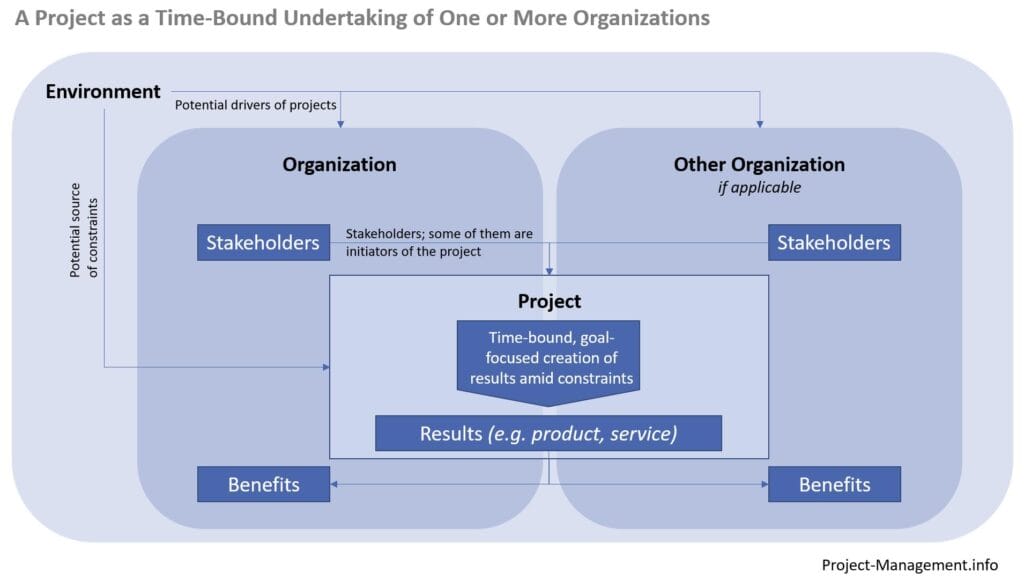There are probably a million definitions of the term “project” out there. Most of them look at projects from a certain angle or perspective and define projects in their own unique way. However, there are also some characteristics and elements that most definitions of projects have in common. Those common aspects are a good starting point to come up with a precise answer to the question “what is a project?”
Rather than developing a new definition (which would be the definition no. 1,000,001 or so), we are consolidating the practically relevant aspects of existing definitions into a simple but precise definition:
What Is a Project?
The term project refers to the time-bound goal-focused creation of results amid several constraints within or across organizations.
This usually requires planning and is to be performed against pre-set scope or budget requirements.
Projects are initiated by one or more stakeholders (sometimes referred to as “project owner”), need to cater for and balance the interests of stakeholders (usually more than just the project owners) and are supposed to deliver a benefit for the organization(s).
Projects are driven by factors outside (e.g. regulation) or inside the organization (e.g. strategy implementation).
Overview of Common Definitions
How Dictionaries and Wikipedia Define “Project”
You have probably looked up the meaning of the term “project” in one of the popular dictionaries or on Wikipedia (which is, at the time of writing, quoting another dictionary).
Merriam Webster defines project broadly as a “planned undertaking”, citing examples from science and education (source).
The Business Dictionary focuses on the commercial and procedural aspects, defining a project as a “planned set of interrelated tasks to be executed over a fixed period” amid costs and other constraints (source).
Other dictionaries and general knowledge sources define projects similarly and use to emphasize three aspects:
- a project is an undertaking,
- it is planned or involves a certain level planning, and
- it is subject to constraints (with time, resources and cost being the commonly mentioned ones).
Although these aspects are still relatively high-level, they form a common foundation of more detailed definitions that we will cover in the following sections.
Scientific Definition of a Project
Among universities and business schools, projects are often defined highlighting aspects of research projects or educational projects (e.g. case studies, surveys and intelligence). However, we have found a more generic approach on the website of the University of Illinois System that supplements the three generic points (see previous section) with, inter alia, the following aspects:
- creation or modification of a product or service,
- being temporary with a defined beginning and end, and
- it can be performed within or across departments and organizations.
Aspects of Projects Highlighted by Professional Organizations
Professional organizations tend to bring in aspects relevant to projects in their respective industries. Associations with focus on engineering or construction will therefore define projects with slightly different criteria than IT-related organizations or research centers.
As this article is dedicated to coming up with broadly applicable yet specific definitions, we will refer to the definition developed by the Project Management Institute (PMI). You can find a publicly available short definition of projects in the context of project management on the PMI website. However, the following points are stemming from PMI’s Project Management Body of Knowledge (PMBOK®, 6th edition, p. 4 – 9) which is PMI’s publication on common project management good practices.
PMI Definition of a Project
The PMBOK sets out the following characteristics in their definition of projects:
- a project is a “temporary endeavor”,
- aiming to create a unique result (which may usually refer to products and services but can also include driving organizational change),
- enabling the creation of quantifiable benefits (also referred to as “business value”), and
- it is initiated by leaders of the organization.
The Institute identified 4 key drivers that drive or require the initiation of projects by the management, namely:
- regulatory, legal and social requirements
- stakeholder needs,
- creation or enhancement of products, processes or services,
- business or technological strategies.
It is not surprising that the Project Management Institute links these points to the inevitable need for a suitable degree of project management which in turn is defined as the application of a set of defined processes to achieve the goals of a project.
Takeaway Points
In the above examples, we have seen different aspects of the project definition, depending on the angle and point of view of those who created them.
The definitions of the term “project” that we have collected and presented in this article became increasingly detailed. For a more generic yet usable definition, we have reduced the level of details a bit to come up with a consolidated answer to the initial question.
We hope you have found this article useful. Feel free to let us know your thoughts!


